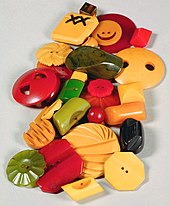Catalin
Catalin is the brand name of a castable, fire-resistant synthetic resin from the group of aminoplasts . It was brought onto the market by the American Catalin Corporation from 1930 after the monopoly of the Bakelite patents with regard to the production and processing of phenoplasts from 1927 to 1931 had expired.
Properties and use
While Bakelite could only be produced in a few dark colors, the new plastic created a colorful palette of bright yellow, orange, red, green and white. Light pastel tones were also possible as well as a multitude of marbling. Some colors proved to be poorly lightfast because the synthetic resins cast at low temperatures changed due to oxidation . The cast material can be for further processing drill , lathe , milling and carving .
The material coined the Hollywood - Design and Streamline Moderne 1930s and triggered in the production of radios Bakelite previously used from. Catalin was also used in Art Deco . Typical products were cigarette holders , lighters , cans, small bowls, handles for cutlery and letter openers , as well as fittings for furniture. Its use for jewelry and buttons was also popular . Here it was also used as an imitation of amber .
Even today there is a collector's interest in so-called Catalin radios and other objects from Catalin. The most famous Catalin radios include the Patriot , which is produced in the American national colors and designed by Norman Bel Geddes for the Emerson Radio and Phonograph Corporation (1940), the Aristocrat , which is made in dark marbled colors, and several models from the FADA Radio & Electric Corporation, such as the Bullet Streamliner (1940–1946) and the 845 Cloud (1946–1950).
Manufacturing
Catalin is a phenol - formaldehyde - resin such as bakelite , Prystal , Marbelette or Durez , but not used in the preparation fillers used. It was made from 1928 until shortly after the end of World War II . Catalin was poured into lead molds and had to cure for five to seven days at 80 degrees Celsius. The rework, cooling , grinding , waxing and polishing took two more days. In this way, not only the variety of colors but also the opacity could be varied. On the other hand, Catalin was expensive due to the complex production process. Catalin tends to shrink over time, presumably due to increasing crosslinking . It could be made as a translucent or marbled material and while it allowed lighter shades than Bakelite, it was not colorless. The successor to Catalin from the American Catalin Corporation was Prystal from 1935 , which was clear and almost colorless, but tended to yellow over time . At the end of the 1940s, Catalin was replaced by cheaper, colored plastics.
See also
literature
- Donna Wasserstrom: Bakelite Jewelry. Schiffer Pub., 1997, ISBN 978-0-764-30122-3 , p. 11.
Individual evidence
- ^ Romana Breuer, Petra Hesse (Museum of Applied Arts Cologne): RadioZeit - tube devices, design icons, internet radio . Kerber-Verlag, Bielefeld, Berlin 2016, ISBN 978-3-7356-0175-9 , p. 16ff.
- ↑ Design of the 20th Century , accessed March 13, 2016.
- ↑ Catalin on Design of the 20th Century, Glossary ( Memento of the original from March 13, 2016 in the Internet Archive ) Info: The archive link has been inserted automatically and has not yet been checked. Please check the original and archive link according to the instructions and then remove this notice. , accessed March 13, 2016.
- ↑ Radio in yellow and light blue on Decophobia
- ^ Objects from the 1930s at Radion Craz: Antique Catalin .
- ↑ a b Leigh Leshner: Collecting Art Plastic Jewelry. Krause Publications, 2005, ISBN 978-1-440-22524-6 , p. 11.
- ↑ a b c David Cycleback: Identifying Common Materials in Antiques: A Pocket Guide. Lulu.com, ISBN 978-1-312-93390-3 , p. 31.
- ↑ a b c d Konrad Birker on Kulturgut Radio , accessed on March 14, 2016.
- ^ Mark V. Stein: Machine Age to Jet Age. Radiomania Books, 1997, ISBN 978-0-964-79531-0 .



